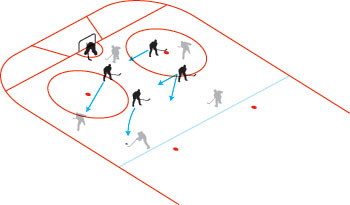by Coach K, AllHabs.net
SAINT-LAZARE, QC.–“You have to play the Box!”
This is the simple coaching strategy when trying to kill off a penalty. Coaches have been saying the same thing for decades. However, the art of playing shorhanded has evolved, just like it’s cousin, the power play. Five-on-four is difficult to defend, five-on-three is nearly impossible.
At it’s most basic level, a penalty killing unit is composed of two forwards and two defenseman when playing at a one man disadvantage. However, there are several factors a coach must take into account when choosing a penalty killing unit:
- Which players have quick feet and can stop and start quickly?
- Which players have the sense to keep their sticks active to block passing lanes?
- Which players are willing to sacrifice their body to block shots or engage attacking forwards physically?
These are just a few of the elements required to be a good penalty killer. There are plenty more. Some coaches think their best offensive players make good penalty killers, because of their ability to read plays and anticipate an opponent’s next move. Others think their role players are more suited for a PK mission.
There really isn’t a right or wrong way to distinguish who’s best to kill a penalty. The most important aspect is the system used, and the players’ willingness to adhere to that system.
“Defend the house!”
When a coach says this, it’s in reference to the prime scoring area, otherwise known as the slot. It extends from each goal post to the hash mark diagonally, and as high as the top of each faceoff circle in the defensive zone. While shorthanded, the opposing team will attempt to place players in that area to get quality scoring opportunities. Players also get in that area in order to screen the goaltender on shots originating from the perimeter.
The strategy behind the Box formation was originally constructed as a means to cover four of the five players on the ice, while your goaltender is accountable for the fifth, and normally undercovered, attacking forward. As power play strategies have evolved, the penalty kill has as well, if only in its variations of the Box.
Let’s start with locating the puck at the point (defensive blue line). When an opposing defenseman has the puck, there must be one forward positioned between him and the house. While this is happening, the weak-side defending forward must place himself between the faceoff circles, in order to block a cross-ice pass, as well as to help cover an opposing player in the high slot. Should the attacking defenseman decide to pass to the weak-side defenseman, then the penalty killing forwards switch positions. This is refered to as a point-high V formation. The ability to stop and start on a dime is key when you are a point-high forward. If these players would continue to skate around, as opposed to stopping to change directions, they would make their jobs must more difficult.
“Collapse down low!”
This is normally done when the puck is located on the half-wall (the area between the faceoff circle and the boards). When this occurs, the Box formation contracts. This involves the point-high forwards postioning themselves inside the faceoff circles, blocking the passing lanes to the points. It also involves the strong-side defenseman positioning himself between the puckcarrier and the net, while using an active stick to block the passing lanes. All the while, the weak-side defenseman places himslef at the net-front position in order to keep opposing players from obstructing the goalie’s view, and the block cross-ice passing lanes.
An artform lost to most players in today’s NHL is the ability to block a shot. This element is key during shorthanded situations. The king of shotblocking was former Montreal Canadiens forward Guy Carbonneau. Carbonneau’s strategy to block shot was to use his legs while extending his body along the ice. This would allow his goalie to assume that if a shot got through, it would be towards the upper tier of the net, since Carbonneau would take away the low shot along the ice. While Carbonneau threw caution to the wind, and sacrificed himself for the good of the team, many players in today’s game refuse to leave themselves prone on the ice, worried about getting injured. This is, as I stated above, one of the key elements of a good penalty killer.
When an opposing team uses a Star powerplay formation, the Box is fairly effecitive in defending against it. If an Umbrella or 1-3-1 formation is using by the opposition, the Box can be rotated into a Diamond formation, with one forward covering the point, two players covering the faceoff circles and one net-front.
According to Bjorn Kinding of Sweden, who does work with Hockey Canada, 30 per cent of all goals scored on the powerplay are originated from plays coming from behind the goal line, 60 per cent of goals come from shots or defections from the point while only 10 per cent come from the half-boards. In his estimation, that means 90 per cent of all powerplay goals only have to beat one defender.
These fundamentals of penalty killing only skim the surface of what is required to be successful when play a man down. With powerplay strategies becoming more advanced, using a constant cycle and positional movement, the fundamental structure of the Box or Diamond become constrewed. Only with hours in the video room, looking over each team’s powerplay on an individual level, can a penalty killing unit really become effective.
(Diagram courtesy ESPN.com, Action photos by Getty Images)
